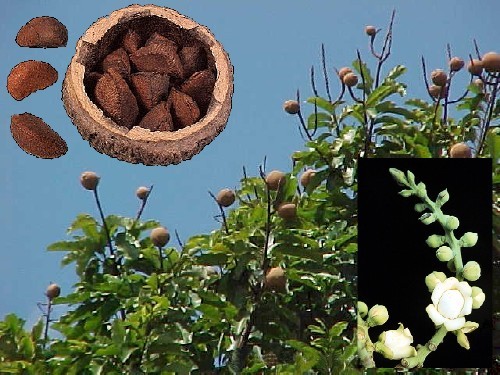

Brazil Nut (Bertholletia excelsa)
Folk Names: Castana-de-Brazil, Castana-de-para, Castanheiro do para, Castania, Creamnut, Nigger Toes, Para-nut
Description: Brazil nut trees are native to the Amazon basin and Rio Negro in Brazil. The trees can reach ages of five hundred to eight hundred years old, forming great forests in the tropics. It will take a tree ten to thirty years just to begin fruiting. It is a tall tree, growing from one hundred to one hundred thirty feet with a trunk diameter of three feet. The limbs and trunk are covered with a scaly bark. The leathery green leaves are alternate, reaching up to twenty inches in length with secondary veins branching from one another without reaching the leaf margin. The Brazil nut tree produces bisexual, creamy-yellow flowers in panicles. The gamosepalous calyx splits in two when the buds open, and has six petals. The fruit is a globoid or elongated capsule about the size of a grapefruit and weighing five pounds. Each fruit contains eight to twenty-four triangular seeds with a rough skin, which is quite stiff, but thin. A mature tree can produce approximately three hundred of these cannonball like fruits which come plunging through the canopy from January to June to strike the ground with enough force to break the fruit into orange-like sections containing the nuts.
Effects: strong
Planet: Mercury Zodiac: Virgo
Element: air
Associated Deities:
Traditions:
For centuries the indigenous tribes of the rainforest have relied on Brazil nuts as an important and significant staple in their dietóso important, that it has even been used as a trade commodity, much like money. The empty seed pods, often called "monkey's pots," are used to carry around small smoky fires to discourage attacks of black flies. They are also utilized as cups to collect rubber latex from tapped trees and as drinking cups.
Magic:
The Brazil nut, with shell intact, is used as a luck or love talisman.
Known Combinations:
none known
Medical Indications: Parts used:
Brazil nut has no medical indications aside from their high nutritional value. They are a source of iron, sulfur, magnesium, selenium, and vitamin E. Brazil nuts are one of the best natural sources of selenium. One single Brazil nut exceeds the U.S. Recommended Daily Allowance of selenium, and the proteins found in Brazil nuts are very high in sulfur-containing amino acids, like cysteine and methionine, and are also extremely rich in glutamine, glutamic acid, and arginine. The presence of these amino acids enhances the absorption of selenium and other minerals in the nut. Selenium is an essential trace mineral in the human body with antioxidant, anticancer, and cancer-preventative properties.
The husks of the seedpods have been used in Brazilian folk medicine to brew a tea to treat stomachaches. The tree bark is also brewed into a tea for liver ailments and diseases.
Nutrition:
Both the nut and itís oil is edible. The nut may be eaten fresh or dried. Indigenous tribes of South America eat the nuts raw or grate them and mix them into gruels. In the Brazilian Amazon, nuts are grated with the roots of Socratea palms into a white mush known as leite de castanha and then stirred into manioc flour. This food is a valuable source of calories, fat, and protein for much of the Amazon's rural and tribal peoples.
Mercantile Uses:
Brazil nut oil is used commercially for scented soap. With such a large oil content, Brazil nuts will burn like miniature candles when lit. The oil is extracted from the nuts and used by indigenous and rural people for cooking oil, lamps, and livestock feed. Exportation of the Brazil nut began in the 1600s with the Dutch traders and is now second only to shipments of rubber. Virtually all harvesting comes from wild harvesting. Not only is this tree a slow fruiter, it requires a specific species of bee to pollinate its flowers. Both of these factors make it unsuitable and unprofitable for plantation cultivation.